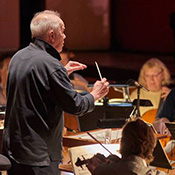
Edo de Waart returns for The Flying Dutchman
David Lewellen
PUBLISHED
Tagged Under: 2018.19 Season, Conductor, opera
A year and a half after stepping down as the Milwaukee Symphony’s music director, Edo de Waart brings a blast of stormy weather into Uihlein Hall this week with Wagner’s The Flying Dutchman.
Symphony orchestras have several options for presenting operas. Staged and semi-staged productions, with sets, costumes, lighting, and movement, take more time and money to produce. Concert presentations, with the singers stationed behind music stands, may seem static in today’s visual culture. But the MSO’s Dutchman, featuring video projections designed by S. Katy Tucker, occupies a middle ground.
“The beauty of the concert hall is that the music gets more emphasis than it does in the opera house,” de Waart said. “We have become so incredibly visual, with movies and TV. This is bringing it back to how it used to be.” But Tucker’s videos may be an enhancement, like skillful lighting in an opera house. De Waart vividly remembers seeing Wieland Wagner’s famed production of Parsifal at Bayreuth more than 40 years ago. “It was mostly done with lights, and it was the first time in my life I had seen something like that. I was just blown away with how so little can do so much.”
As of Friday, de Waart had seen little of the projections, which will follow his tempo. “We don’t work with the video, the video works with us,” he said. “I hope it offers something to the audience.” The singers will stand in front of the orchestra, but de Waart hopes to work out entrances and exits that reflect the stage action — such as the dramatic moment in Act I when the Dutchman comes ashore.
The Flying Dutchman was Wagner’s fourth opera, and his first that is commonly performed today. “It has all the trappings of a great genius writing it, but not having done a lot of it,” de Waart said. While lacking the psychological and musical complexity of later Wagner, “it’s a young genius at work, and it’s very well written for the orchestra and the chorus and the singers.”
Speaking about halfway through the rehearsal period, de Waart said, “It’s going very well,” and he praised the preparation of the Milwaukee Symphony Chorus, directed by Cheryl Frazes Hill. The schedule of nine total rehearsals is about twice as many as a typical classical subscription concert, but de Waart said, “For European standards, it’s a little thin . . . . American orchestras are adapted to work very fast to get to a certain level, but I’m glad we have the chance to get to an extra level.”
Dutchman is Wagner’s shortest opera, with about two and a half hours of music, but the composer meant it to be staged without intermission. The MSO performances will take a break after Act I, for the benefit of the audience and the singers. “The orchestra is fine. They are very tough,” de Waart said. “For me, the adrenaline takes over. We start, and I just go.”
Since stepping down as the MSO’s music director in May 2017, de Waart has scaled back his conducting schedule to spend more time with his family. He is becoming choosier about the concerts he accepts, but “sometimes something comes up that I wanted to pursue, or that we had talked about earlier and now it’s possible. For some pieces, I would certainly make free time.”
The MSO has chosen Ken-David Masur as its new music director, but there will be no formal transition. De Waart knows Masur slightly, and says, “If we are in town at the same time, we will probably have a meal.” But busy conductors’ schedules make that difficult. De Waart fondly remembers one time in 1986, shortly after he became music director of the Minnesota Orchestra, when he had dinner with his two predecessors in that job, Neville Marriner and Stanislaw Skrobaczewski, “and we only told stories. We don’t see our colleagues very often.”
His final responsibility as music director laureate will be to make tenure decisions for the last musicians that he hired. “That is part of why the orchestra plays so well,” he said. In his ten years in that role, “we never had a problem between the [musicians’ audition] committee and me. We always see eye to eye. If you get good players, that is half the ballgame.”



